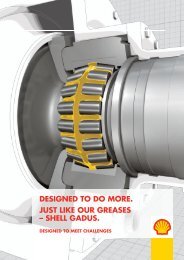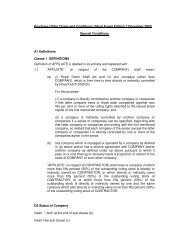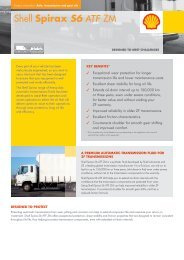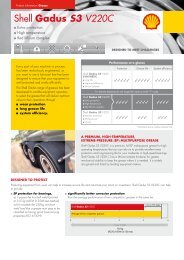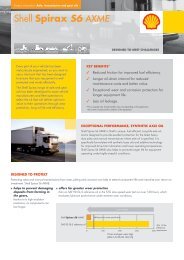KEY LESSONS FROM SUCCESSFUL HYDROCRACKER PROJECTS
KEY LESSONS FROM SUCCESSFUL HYDROCRACKER PROJECTS
KEY LESSONS FROM SUCCESSFUL HYDROCRACKER PROJECTS
- No tags were found...
Create successful ePaper yourself
Turn your PDF publications into a flip-book with our unique Google optimized e-Paper software.
<strong>KEY</strong> <strong>LESSONS</strong><br />
from Successful Hydrocracker Projects<br />
“Pentagon I advocates a focus on operational improvements such as<br />
reliability and energy management projects that do not require capital<br />
expenditure,” he says. “These are short-term initiatives and can help to<br />
fund Pentagon II initiatives, which are short-to-medium-term revamp<br />
solutions. In turn, the cash generated from those initiatives can be used<br />
for the larger, more capital-intensive projects of Pentagon III.” Each of<br />
the three pentagons has investment options on all five sides (Figure 3).<br />
Hydrocracker-related projects are fundamental to this model, as is the<br />
Shell Sulphur Technology Platform.<br />
Designed to help refiners process heavier, sourer crudes, while<br />
meeting stringent emissions and product requirements, the Shell<br />
Sulphur Technology Platform is a portfolio of integrated,<br />
comprehensive technology solutions customised to meet a refiner’s<br />
specific needs. It includes technologies from carefully selected key<br />
companies to manage sulphur in various forms, including sulphur in<br />
crude; sulphur in products; hydrogen sulphide; sulphur dioxide;<br />
mercaptans; and solid sulphur.<br />
<strong>KEY</strong> TRUTH: High-performing companies are enhancing the<br />
viability of major projects by phasing their investment<br />
programmes. They are using the cash generated by low-cost<br />
projects to fund larger, more capital intensive projects.<br />
2. Leverage economies of scale<br />
Maximising the capacity of each train can help to bring capital<br />
expenditure down, says Nicolaas van Dijk, Global Process<br />
Technology Manager, Hydroprocessing, Shell Global Solutions<br />
International BV. But, he says, it is vital for the licensor to be able to<br />
demonstrate that such capacities are achievable.<br />
“To enhance the economics of CNOOC’s new hydrocracker, we<br />
suggested during the development phase that they could achieve the<br />
same capacity from two trains instead of three,” he says. “That<br />
brought the cost down significantly, but an important element of their<br />
decision making was that we were able to show them another site,<br />
the Shell Pernis refinery in the Netherlands, successfully operating a<br />
hydrocracker with similarly sized trains.”<br />
<strong>KEY</strong> TRUTH: Economies of scale can substantially<br />
enhance project economics – but reference sites should<br />
always be studied.<br />
3. Make maximum use of existing equipment:<br />
Integrate solutions<br />
One of the most effective ways to reduce investment costs is<br />
the intelligent integration of process units, writes Yvonne Lucas,<br />
Licensing Technology Manager, Refining, Shell Global<br />
Solutions International BV.<br />
“One customer in Europe wanted to build a mild<br />
hydrocracker complex to process a mix of medium and<br />
heavy VGO, and also to hydrotreat the gasoil from a crude<br />
distiller,” Lucas explains. “We could have offered two<br />
separate standard designs. Instead, to squeeze down the<br />
capital cost, we designed an integrated reactor section: the<br />
hydrodesulphurisation (HDS) reactor and the hydrocracking<br />
reactor were combined with a common separation,<br />
compression and fractionation section. Because the customer<br />
only needed one unit instead of two, the capital cost was<br />
significantly reduced.”<br />
<strong>KEY</strong> TRUTH: Designs should make maximum use of<br />
existing equipment. Integration with other process units<br />
can help to keep costs down.<br />
4. Optimise the conversion level<br />
The greater the level of conversion, the greater the capital<br />
expenditure required. Mike Street, Hydroprocessing<br />
Principal Process Engineer, Shell Global Solutions<br />
International BV, says the licensor’s objective should be to<br />
find the conversion sweet spot, which is strongly affected by<br />
the properties of the feed.<br />
He explains: “In recent projects, we have configured the<br />
hydrocracking processes in such a way that the capital cost is<br />
balanced against the potential margin. Along with the future<br />
www.shell.com/globalsolutions






